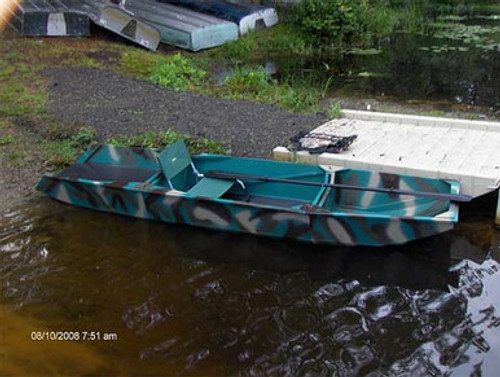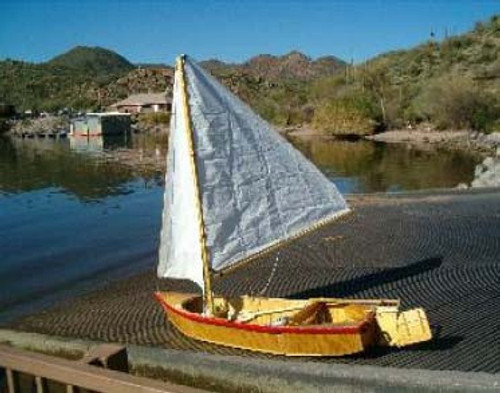Toter DuckBoat specifications:
Assembled | Length : 10 feet 6 inches | |
| Width : 30 inches | ||
| Weight approx. 75 pounds | ||
| Capacity : 325 pounds max. | ||
 | ||
Nested | Length : 4 feet | |
| Width : 30 inches | ||
| Height : 2 feet | ||
Recently I had the experience that all small boat designers relish, the opportunity to assist a boat builder with an unusual request. As the designer of the Toter 3-part-nesting Dingy, I was used to people asking about construction details, but Scott Derr put a twist on it. It seems he is an avid hunter, and wanted to build a small boat that would fit in his Jeep. Of course, that is exactly what the Toter was designed to do. However, Scott also takes his dog Jake, an 80 pound lab, with him on these trips, and Jake fetches the catch, so to speak. Now, I could see how Jake would exit the boat, one big leap. But, getting back into the boat posed a problem. This is where Scott and I scratched our heads for a while. As a result of Jake's added weight and location in the boat, it was obvious the little boat would have to be scaled up. This was no problem however, as the Toter plans already provide an XL version of the boat, primarily so that larger people could also enjoy the Toter experience. But beyond this is where our thinking was put to the test. Finally we decided on an open transom design. Unusual but practical. This would allow Jake to actually climb aboard at water level.
Back to the drawing board. Within a few days I had a sketch that I e-mailed to Scott. Oh yes, we live on opposite sides of the country, he in Pennsylvania, me in Arizona.
He liked the sketch, and the rest is history.
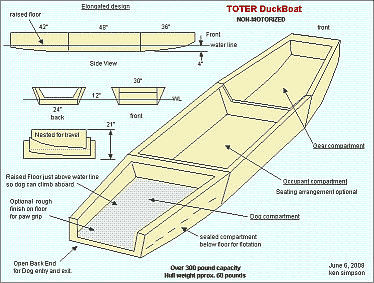
This is the original sketch for the DuckBoat design.
Within a few days the modified Toter drawings were on their way to Scott. Now it was up to him to turn them into a functioning Duck Boat. I must say that Scott asked only a few questions over the next few weeks. He read and analyzed the drawings carefully, planned ahead each assembly step, and expertly built a boat to be proud of.
At this point Scott will explain how he went about the concept for his boat, and what building problems (if any) he encountered.
(Scott Derr)
I had been relying on friends for use of a boat for hunting and fishing, but our schedules usually do not coincide, so I began my search for a boat. The search began with confronting what I could not have:
- 1. Live in center of town with limited space, no room for a large boat and trailer.
- 2. Drive a 2006 Jeep unlimited softtop, so a rooftop boat was not an option.
- 3. Tight budget
While searching for boats I came across the Duckworks Magazine website and was amazed at what people where building. I then noticed the ad for Ken's Toter on the site. The measurments given where immediately checked to see if they would fit in my Jeep and they did. Upon purchasing the plans I noticed Ken included plans for a larger version and the brainstorming began. I contacted Ken and asked some basic questions about a small platform on the back for a dog and he immediately responded, after a few emails back and forth on ideas Ken drew up the plans for an open ended duckboat.
Construction began in the begining of June in the front of my house (it is an old store front and I am single so dust and noise where not a concern). It was a slow process due to work hours and life in general. I stayed in touch with Ken thruout the construction, sending photos and asking questions whenever I needed some direction. As this was my first attempt at boat building I took my time and made sure before anything was cut or installed that it was correct. This entailed holding pieces togther with clamps or by hand and visually confirming all measurements and angles. I decided to make the center and front sections first, as they were covered in detail, and by the begining of July the first two sections where complete and work began on the uncharted rear section.
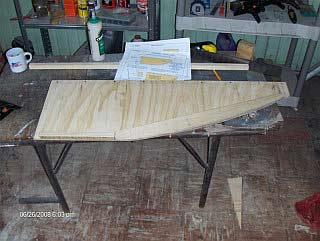
Typical construction, forward side panel. Note plans and flat-surface work space.
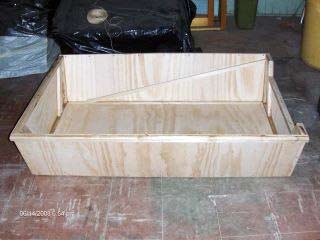
Completed center section. Note also quality plywood selection.
I felt a bit better about my skills and decided to personalize it by cutting the rear sides at a forward angle and using some of my own judgement on some aspects of the build, yet still asked Ken his opinions, relying on his experiance and skill to keep it safe. Overall I feel construction was easy, just take your time and enjoy the process.
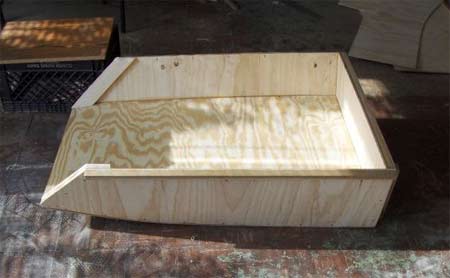
Completed aft section.
The floor is sealed and provides both buoyancy and seating for Jake.
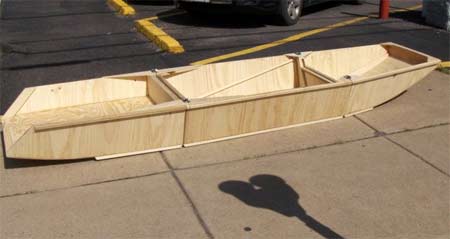
Completed hull sections. Note reinforcing gussets and bottom skids.
Almost 2 months since I first started the boat and
it was complete and ready for it's first test run.
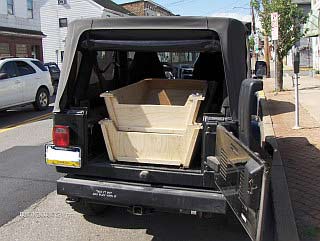
Test fit in the Jeep. Just right, with room to spare.
I bought a 2 piece kayak paddle and a seat because I just couldn't wait to get it in the water. Thunderstorms were in the forecast so I hurried down to the lake without my 4 legged friend. There where a couple of fishermen there who where amazed when I unloaded and put it together, asking many questions about how it was made, and gave me many compliments.
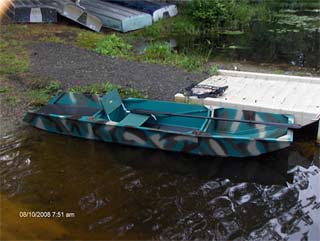
Finished DuckBoat eady for it's maiden voyage ! Love the paint job.
I rowed kayak style facing forward and was amazed at how high it rode in the water, and after a short learning period I was able to make headway and maneuver with ease, with no leaks! Unfortunately the skies opened up and my day was over.

One of the curious bystanders took this picture for me.
Before the next trial planned for the next weekend, oar locks where installed (from Duckworks supply, great price and fast shipping) and I was ready to take along my passenger, my yellow lab Jake. It was a beautiful day and we got to the lake early, a little play time retrieving some sticks and we were ready for his 1st ride in the boat. I sat facing the rear to better control my buddy. I backed into shore and he boarded with shaky legs, and soon realized that laying down or sitting was the best way for him to travel.
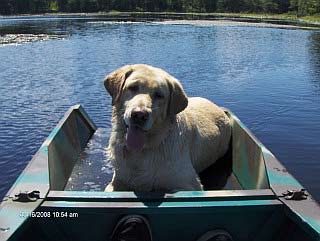
My buddy Jake. Taking it all in, enjoying the ride.
We rowed along for a long time enjoying the day, and while relaxing I noticed how high we still rode in the water. I'm 170 lbs and Jake is 80 lbs, and I am confident the boat can handle all my hunting gear with ease. It will take some time to train Jake to retrieve from the boat, and I am also going to add a flip down ramp in the rear to assist him in getting back aboard from the water, but this may have to wait until winter, as hunting season is upon me.
A great thing about the modular design is the ability to configure the Toter DuckBoat to fit your needs, as I have plans to build another rear section over the winter to accomodate a trolling motor for use in the summertime for fishing.
I hope you enjoy the building and finishing process as much as I did.
Regards,
Scott Derr

